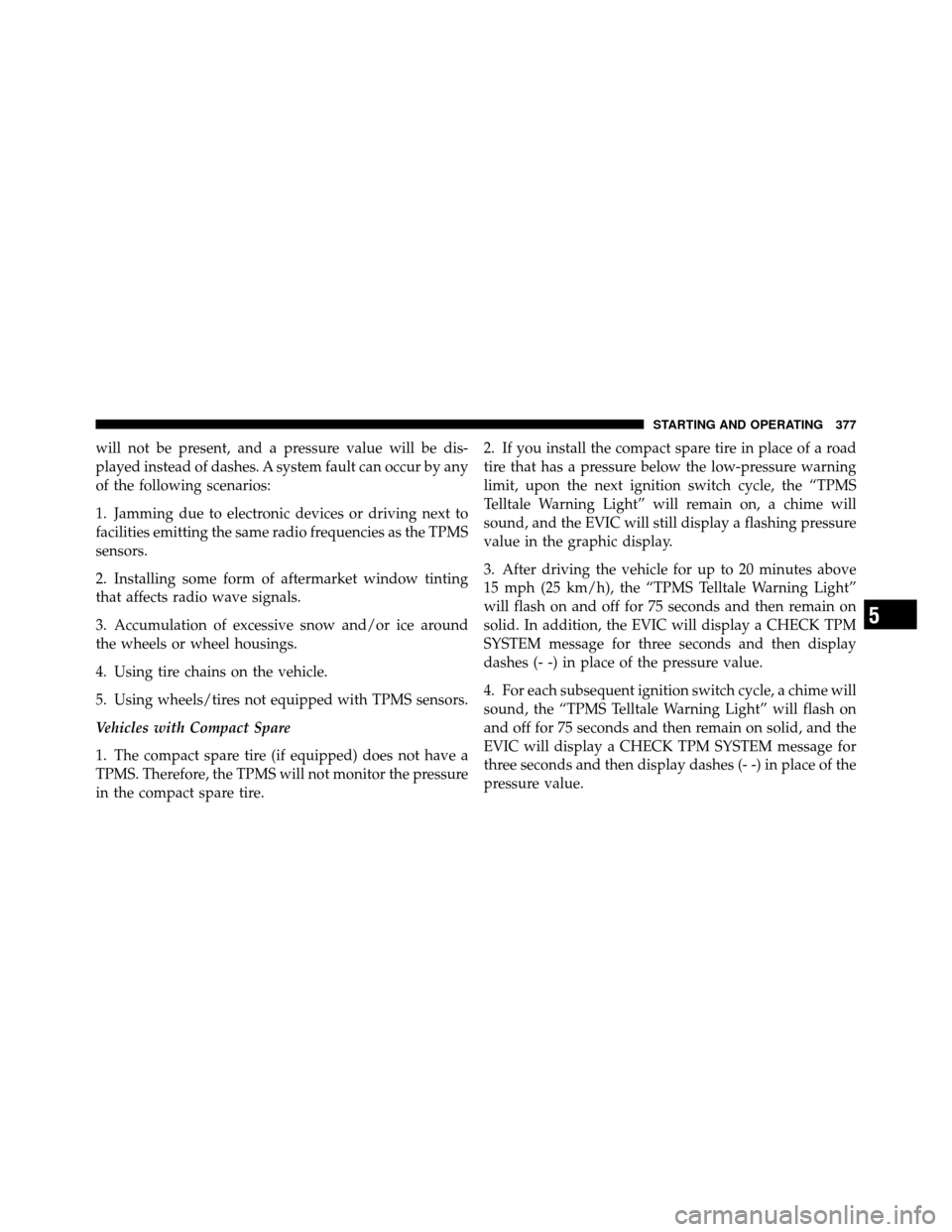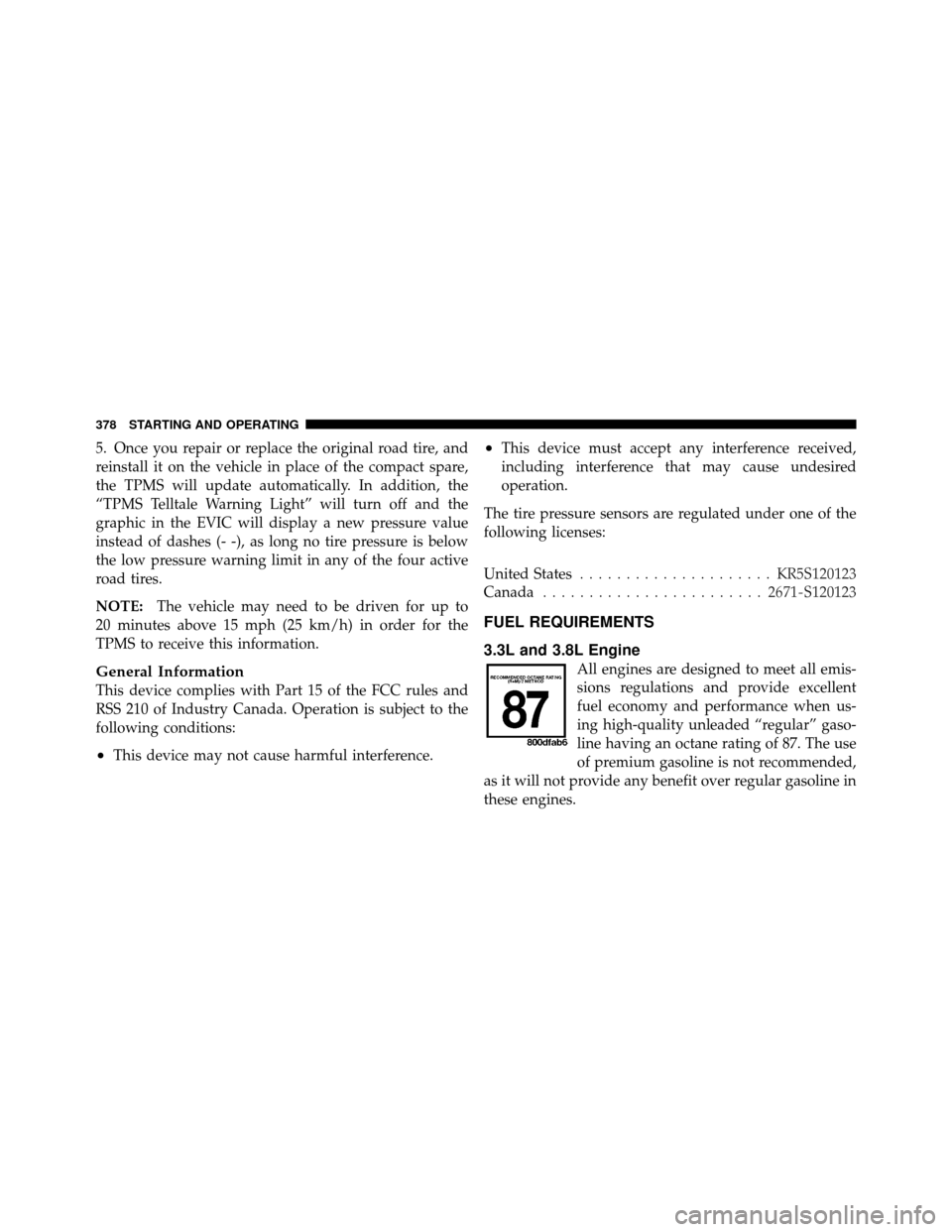sensor CHRYSLER TOWN AND COUNTRY 2010 5.G Owner's Guide
[x] Cancel search | Manufacturer: CHRYSLER, Model Year: 2010, Model line: TOWN AND COUNTRY, Model: CHRYSLER TOWN AND COUNTRY 2010 5.GPages: 538, PDF Size: 10.55 MB
Page 377 of 538

Should a low tire condition occur on any of the four
active road tire(s), you should stop as soon as possible,
and inflate the low tire(s) that is flashing on the graphic
display to the vehicle’s recommended cold tire pressure
value. The system will automatically update, the graphic
display of the pressure value(s) will stop flashing, and
the “TPMS Telltale Warning Light” will extinguish once
the updated tire pressure(s) have been received. The
vehicle may need to be driven for up to 20 minutes above
15 mph (25 km/h) to receive this information.
Check TPMS Message
The “TPMS Telltale Warning Light” will flash on and off
for 75 seconds, and remain on solid when a system fault
is detected. The system fault will also sound a chime. The
EVIC will display aCHECK TPM SYSTEM message for
three seconds. This text message is then followed by a
graphic display, with --in place of the pressure value(s)
indicating which TPMS Sensor(s) is not being received. If the ignition switch is cycled, this sequence will repeat,
providing the system fault still exists. If the system fault
no longer exists, the “TPMS Telltale Warning Light” will
no longer flash, the
CHECK TPM SYSTEM text messageCheck TPM System Display
376 STARTING AND OPERATING
Page 378 of 538

will not be present, and a pressure value will be dis-
played instead of dashes. A system fault can occur by any
of the following scenarios:
1. Jamming due to electronic devices or driving next to
facilities emitting the same radio frequencies as the TPMS
sensors.
2. Installing some form of aftermarket window tinting
that affects radio wave signals.
3. Accumulation of excessive snow and/or ice around
the wheels or wheel housings.
4. Using tire chains on the vehicle.
5. Using wheels/tires not equipped with TPMS sensors.
Vehicles with Compact Spare
1. The compact spare tire (if equipped) does not have a
TPMS. Therefore, the TPMS will not monitor the pressure
in the compact spare tire.2. If you install the compact spare tire in place of a road
tire that has a pressure below the low-pressure warning
limit, upon the next ignition switch cycle, the “TPMS
Telltale Warning Light” will remain on, a chime will
sound, and the EVIC will still display a flashing pressure
value in the graphic display.
3. After driving the vehicle for up to 20 minutes above
15 mph (25 km/h), the “TPMS Telltale Warning Light”
will flash on and off for 75 seconds and then remain on
solid. In addition, the EVIC will display a CHECK TPM
SYSTEM message for three seconds and then display
dashes (- -) in place of the pressure value.
4. For each subsequent ignition switch cycle, a chime will
sound, the “TPMS Telltale Warning Light” will flash on
and off for 75 seconds and then remain on solid, and the
EVIC will display a CHECK TPM SYSTEM message for
three seconds and then display dashes (- -) in place of the
pressure value.
5
STARTING AND OPERATING 377
Page 379 of 538

5. Once you repair or replace the original road tire, and
reinstall it on the vehicle in place of the compact spare,
the TPMS will update automatically. In addition, the
“TPMS Telltale Warning Light” will turn off and the
graphic in the EVIC will display a new pressure value
instead of dashes (- -), as long no tire pressure is below
the low pressure warning limit in any of the four active
road tires.
NOTE:The vehicle may need to be driven for up to
20 minutes above 15 mph (25 km/h) in order for the
TPMS to receive this information.
General Information
This device complies with Part 15 of the FCC rules and
RSS 210 of Industry Canada. Operation is subject to the
following conditions:
•This device may not cause harmful interference.
•This device must accept any interference received,
including interference that may cause undesired
operation.
The tire pressure sensors are regulated under one of the
following licenses:
United States ..................... KR5S120123
Canada ........................ 2671-S120123
FUEL REQUIREMENTS
3.3L and 3.8L Engine
All engines are designed to meet all emis-
sions regulations and provide excellent
fuel economy and performance when us-
ing high-quality unleaded “regular” gaso-
line having an octane rating of 87. The use
of premium gasoline is not recommended,
as it will not provide any benefit over regular gasoline in
these engines.
378 STARTING AND OPERATING
Page 474 of 538

FUSES/TIPM
Cavity Cartridge
Fuse Mini-Fuse Description
J19 60 Amp Yel- low — Radiator Fan
J20 30 Amp Pink — Front Wiper
LO/HI
J21 20 Amp Blue —
Front/Rear
Washer
J22 25 Amp Natural —
Sunroof Mod-
ule
M1 — 15 Amp
BlueRear Center
Brake Lamp/
Brake Switch
M 2———
M3 — 20 Amp Yel-
lowSpare Fuse
M4 — 10 Amp Red Trailer TowFUSES/TIPM
Cavity Cartridge
Fuse Mini-Fuse Description
M5 — 25 Amp NaturalInverter
M6 — 20 Amp Yel-
lowPower Outlet
#1 (ACC), Rain
Sensor
M7 — 20 Amp Yel-
lowPower Outlet
#2 (BATT/ACC
SELECT)
M8 — 20 Amp Yel-
lowFront Heated
Seat – If
Equipped
M9 — 20 Amp Yel-
lowRear Heated
Seat – If
Equipped
7
MAINTAINING YOUR VEHICLE 473
Page 479 of 538

FUSES/TIPM
Cavity Cartridge
Fuse Mini-Fuse Description
M34 — 10 Amp Red Park Assist, Heater Climate
Control System
Module, Head-
lamp Wash,
Compass, IR
Sensor, Rear
Camera, Lamp
Door FT Drv/
Pass, Lamp
Flashlight,
AHLM, Relay
Diesel Cabin
Heater, Rad
Fan Diesel
M35 — 10 Amp Red Heated Mirrors
M36 — 20 Amp Yel- lowPower Outlet
#3FUSES/TIPM
Cavity Cartridge
Fuse Mini-Fuse Description
M37 — 10 Amp Red Antilock Brakes, Stability
Control System,
Stop Lamp
Switch, Fuel
Pump Rly Hi
Control
M38 — 25 Amp NaturalDoor Lock/
Unlock Motors,
Liftgate Lock/
Unlock Motors
The heated mirrors, lower instrument panel power outlet
and removable floor console, when in the front position
are fused with self-resetting fuses that are only service-
able by an authorized dealer. The power seats are fused
by a 30 Amp circuit breaker located under the driver’s
seat. The power windows are fused by a 25 Amp circuit
478 MAINTAINING YOUR VEHICLE